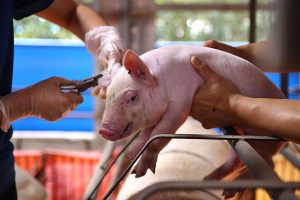By Beatriz Marie D. Cruz, Reporter
THE GOVERNMENT must rationalize spending to meet its deficit and growth targets in the coming years, with military and uniformed personnel (MUP) pensions and excess spending by politicians singled out for cuts, analysts said.
“(The government should) address the fiscal problem by pursuing the reform of the MUP system, stripping from politicians large budgets that will be used for electioneering, while increasing revenues,” Filomeno S. Sta. Ana III, coordinator of Action for Economic Reforms (AER), said via Viber.
They said the government should also inject a dose of reality in its deficit projections.
“I would’ve liked to see a more realistic assessment of this year’s deficit target; 5.3% of GDP (gross domestic product) would still be a stretch,” Pantheon Macroeconomics Chief Emerging Asia Economist Miguel Chanco said in an e-mail.
In a briefing last week, the Development Budget Coordination Committee (DBCC) raised the deficit ceiling for 2025 to P1.537 trillion from P1.490 trillion, pushing the deficit-to-GDP projection to 5.3% from 5.2% in April.
For this year, the DBCC maintained its deficit projection at P1.48 trillion, or 5.6% of GDP.
“Our current (deficit) forecast is unchanged at 6%, with the pace of fiscal consolidation having slowed materially in recent quarters,” Mr. Chanco added.
At the end of March, the deficit-to-GDP ratio stood at 4.46%, against 4.82% a year earlier and 6.2% at the end of 2023, the Bureau of the Treasury (BTr) said.
The National Government’s budget deficit widened to 43.1% to P174.9 billion in May from P122.2 billion a year earlier.
Government spending jumped 22% to P557 billion, offsetting the 14.59% revenue expansion, the BTr said last week.
Last week, the DBCC raised its revenue targets to P4.644 trillion (from P4.583 trillion previously) for 2025; to P5.063 trillion (from P4.956 trillion) for 2026; to P5.627 trillion (from P5.487 trillion) for 2027; and to P6.25 trillion (from P6.078 trillion) for 2028.
During the briefing, the Finance department said increased collections by the Bureau of Internal Revenue and Bureau of Customs (BoC) would offset its “no new taxes” agenda.
BIR revenue rose 2.79% to P219.2 billion in May, while BoC collections rose 4% to P81.753 billion.
However, Finance Undersecretary and Chief Economist Domini S. Velasquez said that pending tax measures in Congress are expected to generate P42 billion in revenues yearly.
These bills include the value-added tax on digital service providers, the excise tax on single-use plastics and pickup trucks, the new mining fiscal regime, the motor vehicle road user’s tax, and Package 4 of the Comprehensive Tax Reform Program.
To meet its deficit goals, the government must curb overspending and all forms of tax evasion, Mr. Chanco said.
“Collection could still be enhanced if the government cracks down hard on evasion, but this is a long-standing problem in the Philippines for a reason. Ultimately, it will have to come down to a difficult choice of rationalizing — i.e., cutting — government spending, which is obviously politically difficult.”
Meanwhile, the unchanged growth targets through 2028 were unrealistic, Mr. Chanco said, citing the weak financial health of individual consumers.
The overall consumer confidence index for the next quarter fell to -0.4% from 2.7% previously, according to the Bangko Sentral ng Pilipinas (BSP) Consumer Expectations Survey.
The DBCC retained its GDP growth targets for this year at 6-7% amid external headwinds. It also kept its growth targets for 2025 at 6.5-7.5% and 6.5-8% until 2028.
“Inflation should start to slow materially in the second half of the year, but this will provide only minimal relief to growth, especially with the BSP likely to keep policy relatively tight, in real (inflation-adjusted) terms,” Mr. Chanco said.
In its policy meeting last week, the central bank lowered its risk-adjusted inflation forecast to 3.1% this year from 3.8% previously, citing the impact of lower import tariffs on rice under Executive Order No. 62.
To achieve the country’s growth prospects, AER’s Mr. Sta. Ana cited the need to balance imports to lower food prices while enhancing the productivity of farmers and producers through consolidation and adoption of new farming technologies.






